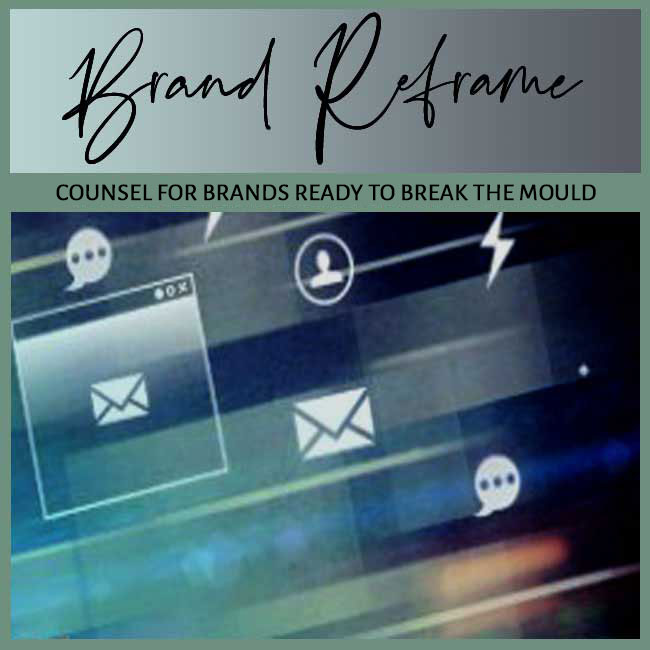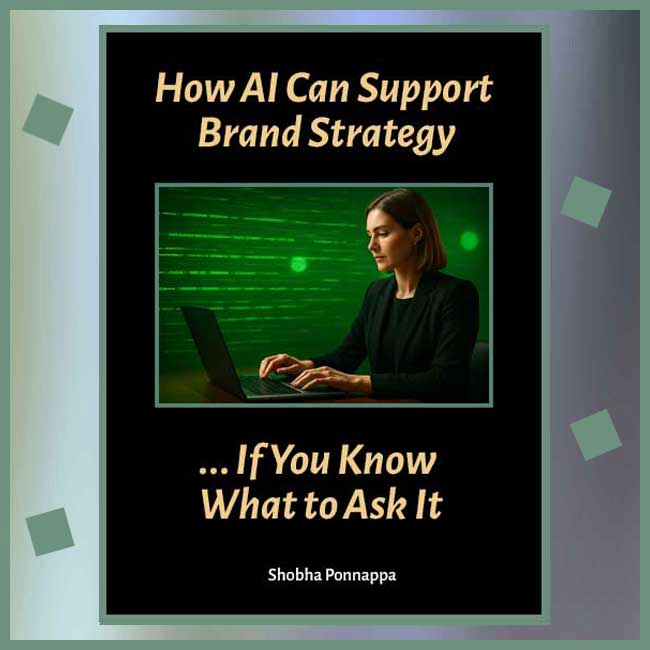
Not with more content, more noise, or more of the same – but with one sharp, strategic idea that reorients everything.
In over 40 years of working with 125+ brands across advertising, digital marketing, and content strategy, I’ve seen this truth hold up: brands don’t stagnate because they lack effort – they stagnate because they lose clarity.
When markets shift, competitors multiply, or once-effective messages begin to blur, you need a shift – one bold, strategic reframe that changes how your brand shows up and moves forward.
That’s where I come in. I offer a progression of three services, each designed to do one thing …

Every brand hits moments where what once worked no longer does. The instinct is often to do more – more content, more channels, more campaigns.
But what’s needed isn’t volume. It’s direction.
That’s why I’ve shaped my work around one purpose: helping brands rediscover clarity, unlock bold strategic shifts, and move forward with confidence.
Below are three distinct ways we can work together – each designed to meet you exactly where you are, and take you where you need to go next.
Brands don’t always stall because they’re broken. More often, they get stuck when once-effective strategies stop working, but the momentum to pivot hasn’t yet arrived. The symptoms creep in – slower growth, lower engagement, scattered messaging, or a quiet sense of disconnect between what the brand says and what the audience hears.
Sometimes the challenge is internal: too many priorities, too much content, or a legacy strategy that no longer reflects the market. Other times, it’s external – competitors shifting faster, audience expectations evolving, or noise in the category dulling differentiation.
What keeps a brand stuck is rarely a lack of action. It’s a lack of clarity. The answer isn’t more effort – it’s a sharper way forward.
In the face of stagnation, the instinct is often to add: more content, more features, more channels, more noise. But complexity rarely moves a brand forward – it muddies the signal and dilutes the message.
Clarity is what creates traction. It aligns teams, sharpens decisions, and reconnects the brand with what makes it different. It simplifies not by dumbing down, but by cutting through – the right idea, expressed the right way, at the right moment.
Complexity overwhelms. Clarity unlocks. And when a brand suddenly sees itself – and is seen by others – with sharper definition, momentum follows.
Breakthroughs don’t always come from an overhaul. Sometimes, it’s a single shift – a new lens, a reframed message, a sharper promise – that cascades across everything a brand touches.
The right shift reveals what was already there, but out of focus. It brings coherence to content, strength to positioning, and direction to action. Internally, it unites teams. Externally, it clarifies value.
Reframing isn’t about doing more. It’s about seeing more clearly – and acting with precision. One well-placed shift can transform not just perception, but performance.
No two brands get stuck in quite the same way – and no two breakthroughs look alike. Strategy that truly works begins with recognising where a brand is, what it needs now, and what kind of clarity will create movement.
Some brands need a swift, high-impact reframe. Others need deeper strategic recalibration. Still others need support to translate bold thinking into action. The point is not to follow a formula – it’s to meet the moment with the right level of depth and direction.
That’s why my offerings are tiered – not templated. Each one is a different kind of intervention, tailored to fit the shape and scale of your challenge.
Strategic support shouldn’t overwhelm – it should meet you where you are. Whether you’re looking for a quick, high-clarity intervention or a fuller partnership to activate and implement, each tier of my offering is shaped around how much depth, time, and transformation you need.
Some clients come with a clear challenge and want a sharp perspective fast. Others need space to explore, reframe, and translate that strategy into a focused activation plan. Still others require hands-on support as they bring a big idea to life.
What links all three? A shared goal: to deliver the one shift that unlocks clarity, alignment, and forward movement.
Every strategic breakthrough starts with a spark – the moment something clicks, and the way forward becomes clearer. But clarity alone isn’t enough. It needs to be carried through decisions, messaging, content, and execution to create real alignment.
That’s why my offerings aren’t isolated services – they’re part of a progression. You can start with a Clarity Sprint and stop there. Or, if the insight reveals a deeper need, you can build on it with a more immersive shift or sustained support.
Whether you need a fresh angle or a full realignment, the goal is the same: to get your brand unstuck and moving with purpose, consistency, and conviction.

If your brand feels stuck, stalled, or unsure of its next move, the Clarity Sprint offers a sharp reset. This one-time, two-hour consult is designed to cut through swirl, diagnose what’s off, and uncover one bold idea that can unlock forward movement.
It’s ideal for founders, brand leads, or marketers looking for clarity – not complexity. After the session, you’ll receive a focused Strategic Summary with your breakthrough idea and next steps, delivered within five working days. The result: renewed focus, sharper positioning, and strategic confidence to lead your brand forward.
The Clarity Sprint is a one-time, high-focus engagement designed to deliver maximum value in minimal time. It includes:
Your investment: USD $1000
This isn’t a workshop or a generic consultation. It’s a sharp, strategic intervention for brands that are ready to shift, simplify, and move forward with purpose.

For brands that need more than a spark – this is where we go deeper. The Breakthrough Blueprint is a short-term, high-impact engagement that takes your strategic insight and expands it into a full roadmap. We define your unique positioning, shape a campaignable big idea, and outline how to bring it to life through content, messaging, and execution priorities.
It’s ideal if your Clarity Sprint revealed a bigger opportunity – or if you already know you need a brand reset with sharper structure. You’ll walk away with clarity, a differentiated idea you can own, and a full blueprint to align your internal team or external partners.
The Breakthrough Blueprint is a 3 week engagement that includes:
Your investment: USD $4000
This is a focused, collaborative process designed to give your brand strategic sharpness and momentum – fast.
NOTE: This service is available only after a Clarity Sprint. If your brand challenge calls for a deeper reframe, roadmap, and activation plan, we move into this next tier – together.

When your brand is ready to activate the big idea, I offer execution oversight to ensure it’s led with the same strategic sharpness it was created with. For 8 weeks, I stay closely aligned with your rollout – tracking how the strategy translates across content, messaging, and key touchpoints. This is not project management or team supervision. I do not select or manage your internal teams or agency partners. What I provide is high-level strategic guidance to preserve the clarity, cohesion, and intent of your breakthrough.
You’ll have weekly alignment calls, direct access to me for feedback on key executional materials, and ongoing calibration to keep your people and processes strategically on course. Timelines, production, and delivery remain your responsibility – but I help ensure what reaches your audience is smart, aligned, and true to the reframe we’ve crafted. It’s brand stewardship, not operations – and it keeps your investment in strategy sharp through to execution.
Execution Oversight is an 8 week engagement that includes:
Your investment: USD $13,000
This is not project management. It’s senior strategic supervision – ensuring the bold idea we’ve created is carried through with consistency, intent, and clarity. Timelines, delivery, and operations remain your team’s responsibility. I keep the strategy sharp and alive.
NOTE: Only offered to clients who’ve completed the Breakthrough Blueprint. This tier ensures the big idea is carried through with integrity and precision during rollout.

Some brands need more than a single breakthrough – they need sustained clarity to navigate what’s next. After our work together, you may want to retain access to me for strategic input as new decisions arise, new content is created, or the brand evolves in-market. This is not about recurring deliverables or daily oversight. It’s for founders, brand leaders, and CMOs who want expert thought partnership and brand stewardship on call.
This access is available only after we’ve done deep strategic work together. You can engage me through a monthly retainer for predictable access, or on a per-hour advisory basis when you simply need a sounding board. Either way, you continue to benefit from strategic alignment, message refinement, and consistent momentum – without the need to start over each time.
Ongoing strategic access is available in two forms:
or
This tier gives you continuity, clarity, and counsel – without rebriefing or recontextualising every time. You stay sharp. I stay close.
NOTE: Ongoing strategic access is available only after a full engagement. You can retain me monthly or by the hour for continued brand clarity, oversight, and refinement.

If you’d like to bring the breakthrough idea to life through high-quality, content-led execution, my trained and experienced team is available to implement what we’ve strategically outlined. This isn’t a generic content service. It’s a curated implementation stream that flows directly from the strategy we’ve built together – ensuring that the clarity, tone, and differentiation hold through every touchpoint.
Implementation Services are available only if we’ve already worked together on a Clarity Sprint, Breakthrough Blueprint, or Execution Oversight. You get execution that’s aligned and intentional – without losing time in rebriefing or external orientation. I stay involved to ensure fidelity to the original breakthrough, and my team delivers with polish, precision, and purpose.
Implementation is scoped only after your strategic roadmap is in place. Every campaign, content stream, or activation idea we generate will require different deliverables – and different formats. My team and I cost these as itemised elements, based on the content mix we recommend and the platforms you intend to activate.
Pricing is fixed per asset – whether it’s a website page, blog, email, Instagram reel, or press release. You’ll receive a clear proposal with deliverables, timelines, and individual costs, so nothing is ambiguous. Innovation happens at the strategic level – but execution is sharp, grounded, and well-defined.
NOTE: Implementation is not offered standalone. If we’ve co-created the strategy, my experienced team can execute key deliverables that bring the idea to life.
Your next breakthrough begins with a single shift. Let’s uncover it – together.
Smart insights, real-world frameworks, and idea-driven clarity – designed to help brands move.
Get my fortnightly Brand Reframe newsletter. Smart insights, distilled thinking, and focused momentum to help your brand lead.

Get my free AI strategy guide. Smart prompts, sharper briefs, and practical ways to make AI support your brand momentum.

Just fill in the form to join. Get my newsletter and the guide shown alongside, all with several game-changing tips.
I Bring You:
Smart insights, real-world frameworks, and idea-driven clarity – designed to help brands move.
Get my fortnightly Brand Reframe newsletter. Smart insights, distilled thinking, and focused momentum to help your brand lead.

Get my free case studies guide. Practical ideas, bold shifts, and clever transformations to propel your brand forward.

Just fill in the form to join. Get my newsletter and the guide shown alongside, all with several game-changing tips.